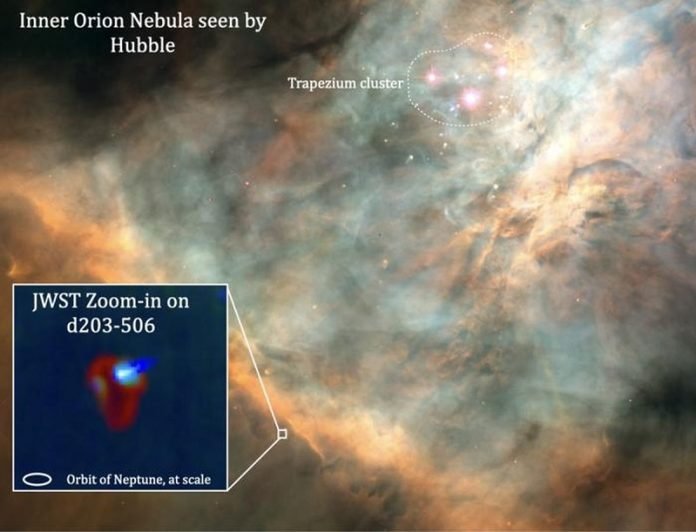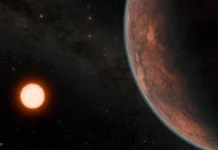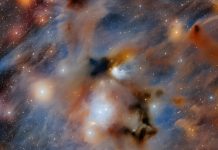
Stars shape their solar systems. It’s true of ours, and it’s true of others. But for some massive stars, their power to shape still-forming systems is fateful and final.
In their youth, stars are surrounded by a rotating mass of gas and dust called a protoplanetary disk. Planets form in these disks, and the process can take millions of years.
But stars have different masses and different radiation outputs that affect how planets form, or if they form at all.
New research examines how the powerful UV radiation from massive stars affects planet formation in disks. The research article is “A far-ultraviolet–driven photoevaporation flow observed in a protoplanetary disk.”
It’s published in the journal Science, and the lead author is Olivier Berne from the Institute for Research in Astrophysics and Planetology, University of Toulouse, France.
The research looks at large stars in their first million years of life, when they’re not only young but extremely luminous. The researchers focused on several stars in the Orion Nebula and its stellar nurseries. The stars are at least ten times more massive than the Sun and are 10,000 times more luminous. What effect does their luminosity and all that radiation have on disks where planets form?
These powerful young stars emit high levels of Far-Ultraviolet (FUV) radiation, which has the power to remove mass from planet-forming disks. This power extends beyond their own immediate surroundings into the disks around neighbouring low-mass stars.
“Most low-mass stars form in stellar clusters that also contain massive stars, which are sources of far ultraviolet (FUV) radiation,” the researchers explain.
“Theoretical models predict that this FUV radiation produces photodissociation regions (PDRs) on the surfaces of protoplanetary disks around low-mass stars, which affects planet formation within the disks.” The PDRs can span several hundred astronomical units (AU).
The researchers examined one protoplanetary disk that’s within range of energetic, high-mass stars residing in the Trapezium Cluster in the heart of the Orion Nebula. The five brightest stars in that cluster range from 15 to 30 solar masses, making them prime candidates to study PDRs in neighbouring planet-forming disks. The Orion Bar PDR is an often-studied and prototypical PDR
The disk in the image, d203-506, is being bombarded by intense FUV radiation from the massive Trapezium stars. The FUV radiation is dispersing matter in the disk, inhibiting planet formation. According to the research, it’s impossible for a Jupiter-mass planet to form in this disk because the radiation is stripping matter away.
“Planet formation is limited by processes that remove mass from the disk, such as photoevaporation,” the authors write. “This occurs when the upper layers of protoplanetary disks are heated by x-ray or ultraviolet photons.” Once heated, the gas exceeds the escape velocity of the disk, and the gas leaves the system.
After the radiation drives mass out of the disk, it collects in a diffuse envelope around the disk.
The powerful FUV radiation dissociates molecular hydrogen into atomic hydrogen. The PDR marks the transition between molecular and atomic hydrogen. As the hydrogen is converted into atomic hydrogen, it becomes warmer, and the heating helps drive the photoevaporation of the hydrogen.
When the star inside the affected disk is more massive, that helps restrict the loss of hydrogen from the disk. Its gravity can help the disk retain matter, making it available for planet formation.
This all plays out relatively quickly in a disk. In the d203-506 disk, the star is only about 0.3 solar masses. The researchers write that in only about 0.13 million years, enough material will be removed from the disk to prohibit the formation of a Jupiter-mass planet. “This is faster than even very early planet formation,” the researchers write.
But powerful FUV radiation and the PDRs they produce do more than just inhibit the formation of gas giants. They shape other aspects of the future solar system as well.
“The effect affects the disk mass, radius, and lifetime, its chemical evolution, and the growth and migration of any planets forming within the disk,” the authors explain.
Written by Evan Gough/Universe Today.



